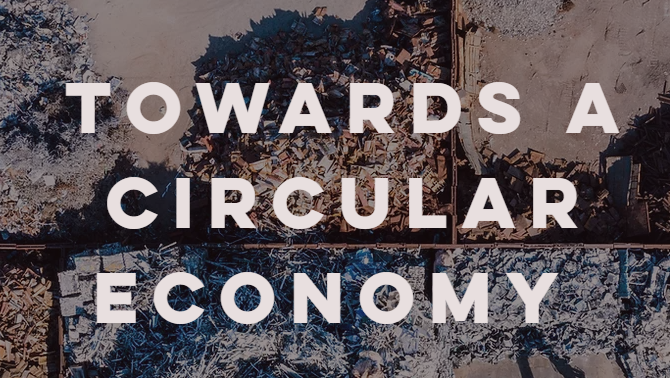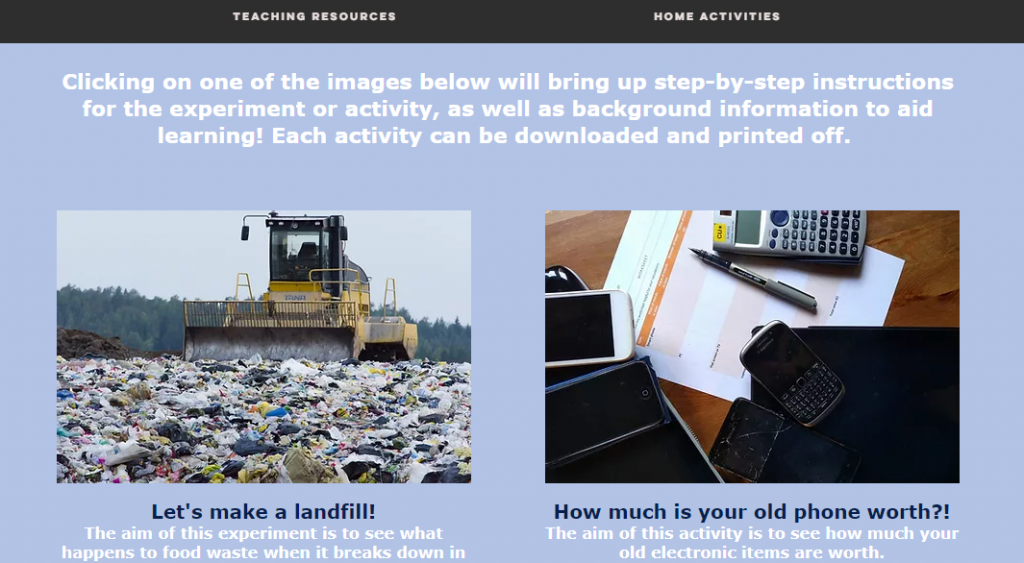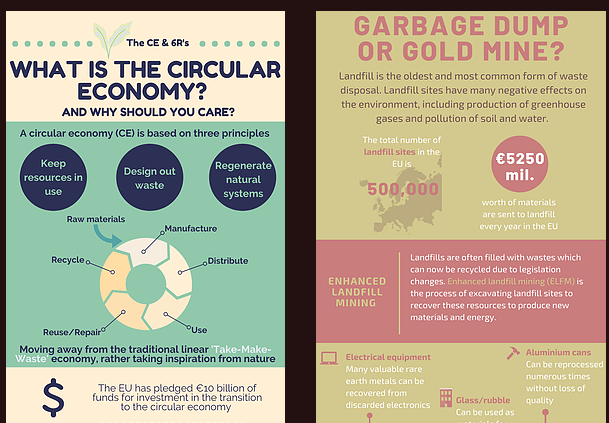
September 9, 2020, by Jo Gregory
A different class: an education in the circular economy
With the enforced closure of the University due to COVID resulting in limited access to labs, a group of first year PhD students from the EPSRC Centre for Doctoral Training in Sustainable Chemistry faced an uncertain start to their studies, specifically the need to rethink their end of year project on the circular economy. Adapting brilliantly to new constraints they identified a gap in existing resources for secondary school students – engaging and accessible materials that help explain the concept. They spent the next few months researching, producing and evaluating a series of educational materials that could be used by teachers in the classroom as well as activities that can be done at home. Luke Woodliffe, Amy-Louise Johnston, Harriet Fowler and Thomas Butler talk to Jo Gregory about the project and the importance of introducing concepts around sustainability at a young age.
What is the circular economy?
The circular economy presents the idea that nothing should become waste, and everything should be kept in a ‘useful state’ for as long as possible through reducing, reusing, repairing, and recycling objects rather than disposing of them. This is proposed as an alternative to “make-take-dispose” processes currently found in nearly all industries across the world. For example, rather than accepting an upgrade to a new mobile phone as soon as the network provider offers one, and leaving the ‘old’ mobile phone in a drawer unused, a circular economy would promote that:
• A mobile phone should be used for as long as it is functional
• If the phone breaks the owner should try to have it fixed
• If the whole phone cannot be fixed different components of the phone, such as the screen, should be used to refurbish another broken mobile phone. The phone should have been designed by the manufacturer to make this as easy as possible to do.
• When there are no useful parts left of the phone it should be disposed of correctly, sending it to a WEEE (Waste Electrical and Electronic Equipment) recycling centre to be recycled. These recycled materials would likely go into manufacturing a new phone.

Diagrams from the website illustrating the linear vs circular economy.
Why is it important to teach children (and adults) about the circular economy?
The interest around a circular economy is growing exponentially, in both research and business communities, and has been highlighted as an area which can make a huge impact on sustainability. For this reason, we think that students should be introduced to these topics early in their education so they can become future leaders in the field of a circular economy.
Who are the materials aimed at and why did you choose this particular audience?
Currently, our main audience is secondary school pupils, particularly around GCSE age. At this point, some of the principles of the circular economy start to show up in more detail in the subject-specific curricula. We hope the resources we have developed will allow pupils to go deeper into some of the issues around waste and the circular economy and motivate students to want to make a difference in these fields. Having said that, many of the materials can be adapted by teachers to suit different ages and learning environments, so should find broad application.

The website includes home activities as well as teaching resources.
What do you hope to achieve from this project?
We hope to increase the understanding of the circular economy and its importance, but we appreciate that scientific papers aren’t the most accessible resources for most people. As such, it seemed appropriate to help to spread this information using an easily accessible, free, and easy to understand medium. The creation of a website with relevance to the school curriculum and fun practicals was an attractive way to deliver this. We hope that the resources will inform students, teachers, and parents alike.

Lesson plans cover several topics including the circular economy and food waste.
What is your background? What brings you to the Centre for Doctoral Training (CDT) in Sustainable Chemistry at Nottingham?
Luke: I studied organic and inorganic chemistry at the University of Cambridge, and have also worked in research and development in the pharmaceutical industry for a few years after graduating. I applied for the CDT wanting to research into areas around sustainability which can make a positive difference to society and the environment.
Hattie: I recently completed a Masters degree at Durham University in chemistry with a background in organic chemistry and sustainability. I chose to apply to the CDT at Nottingham to further my research into sustainability and the circular economy.
Tom: I did my integrated Masters degree here at Nottingham, where I had the chance to specialise in medicinal chemistry and natural product synthesis through my year in industry and masters projects respectively. I chose to stay with the university after graduation because of the excellent department and the quality of research here, the CDT provided the opportunity to focus on sustainability and seemed like the right choice for me to develop into a well-rounded scientist.
Amy: I also completed a Masters degree in chemistry, at the University of Southampton. Between finishing my degree and starting my PhD, I worked at a large international academic publisher, focusing on Environment and Sustainability publications. The CDT gives me a chance to combine several of my academic interests, allowing me to learn more about the circular economy and sustainability whilst also carrying out my own novel research in the area.

The GSK Carbon-Neutral Laboratory for Sustainable Chemistry, which is home to the CDT.
How has COVID affected your studies and research?
Luke: It has meant significantly reduced time in the lab for experimental work, moving research online for the time being.
Hattie: The pandemic has put a halt on lab-based activities for now, therefore, with much more time spent online, we decided to create an educational website based on different areas of the circular economy we have learnt about.
Tom: The lab closure has meant a significant amount of time has been spent working from home. Online research is something I had little experience of prior to the pandemic, but it is a skill that I am glad to have developed over this time.
Amy: COVID has certainly affected the first year of the CDT, as being unable to carry out lab work has meant lots more desk-based research. Alongside lots of reading around my PhD topic, it has presented an opportunity to develop new skills in areas, such as creating educational materials and a website, I otherwise would not have had the chance to do.

Infographics produced by the students outlining key concepts.
What are your aims for the future?
Luke: To make a positive contribution to the research area of carbon capture and to continue research with a role either in academia or industry.
Hattie: To help contribute to a sustainable future through further industrial research.
Tom: To enable the more sustainable development of pharmaceuticals both through my PhD and in my subsequent career.
Amy: To keep developing ideas around how chemists can contribute to sustainability and the circular economy, then apply and share these principles in any future role.

Infographics produced by the students with key concepts and statistics.
Do you have any advice for young scientists?
Luke: When thinking about an area for research, find a field you enjoy and find meaningful, and always try to keep things in perspective.
Hattie: Be passionate and ask lots of questions!
Tom: Try to do something that you enjoy and have a passion for. Learn from others who are older than you by asking lots of questions, the vast majority of people in science love to discuss their research and experiences!
Amy: Question everything! And, do not worry if you don’t understand something the first time. Nearly all areas of science contain complex ideas which are not straightforward, so if you don’t understand something find someone who does and ask them to explain it.
You can access the resources at circulareconomyresources.com. To find out more about the EPSRC Centre for Doctoral Training in Sustainable Chemistry please visit the website.
To find out more about the Green Chemicals Beacon and how our team of researchers are working to secure the low carbon economy of the future, please visit the website or follow us on Twitter @UoN_GCB
No comments yet, fill out a comment to be the first

Leave a Reply